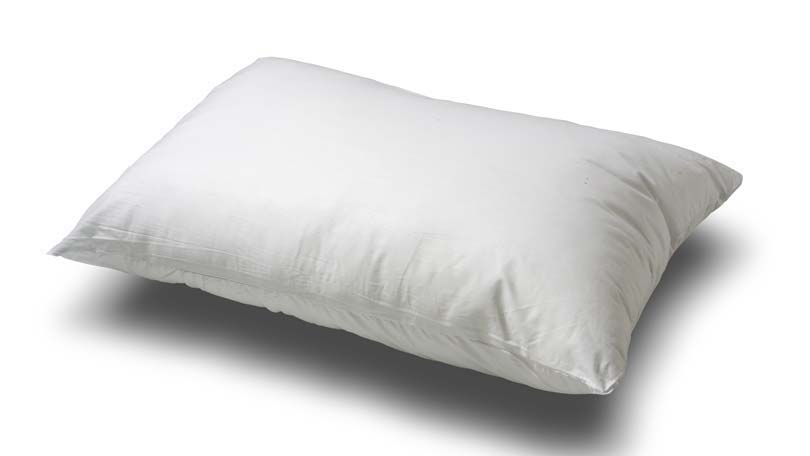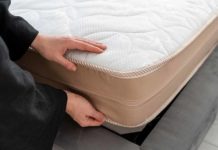
Pillows are an essential bedding item, although the type, size and number you buy will be your own personal choice.
Essentially the function of pillows is two-fold; they provide support for your neck and shoulders, and they provide a nice soft and comfortable surface to lay your head. So if you want to know what to look for when buying bedroom pillows, support and comfort should be at the top of your list. But another important factor is the filling used to stuff the pillow.
Fillings for Bedroom Pillows
Generally speaking, the fillings used for pillows are the same as those used for duvets. They include:
- Goose down, which is light and fluffy, without any of the quills you find with feather. It is the most expensive filling type.
- Duck down, a close second to goose down in terms of price, is similarly light and fluffy.
- Down and feathers or feathers and down, depending which stuffing forms the greater volume, is a compromise between down or feathers.
- Feathers, which are treated to make them more resilient, and able to return to their original shape.
- Fiber fillings which are synthetic, relatively inexpensive, normally non-allergenic, and generally soft and resilient.
- Foam fillings that range from polyester foam chips to latex rubber foam.
- Dried hops, which are usually mixed with either feathers or polyester.
A down filling creates a lovely soft pillow that has natural buoyancy. The pressure from your head, neck and shoulders, effectively causes the tendrils of the down to open, and pockets of air fill the tiny voids. This gives excellent support. A good quality down pillow, whether stuffed with goose or duck down, should last for at least ten years.
Feathers tend to make pillows firmer, but this doesn’t necessarily mean they give superior support.
Generally, if a pillow is labeled “down and feathers” you can expect there to be at least 51% down in the content of the filling. It is a good option since you will benefit from the warmth, lightness and support offered by down, and the firmness and relative softness of the feathers. A down and feather pillow will last longer than a feather and down pillow, which is likely to contain at least 15% down, and usually not much more.
Normally pillows filled with synthetic fiber of some sort are soft and resilient. They are also the easiest type of pillow to wash.
Polyester foam pillows are the cheapest of all, but unfortunately they also tend to be less comfortable than most because they quickly become lumpy. They are, however, non-allergenic and washable, so are often considered to be a good option for guest and children’s rooms.
Latex foam pillows are also washable and non-allergenic. Because they are made from a form of liquid rubber, they are also said to be germ-repellant. This type of foam is firm and springy, and you’ll either love sleeping on these pillows, or you’ll hate them!
Hop pillows have been made for centuries, supposedly for their sleep-inducing properties, to help insomniacs sleep and to reduce anxiety. The secret of hops is in lupulin, a substance that is found in the hop fruit. Nowadays a range of different herbs is used in pillow stuffing for similar reasons, although you will only find these pillows at specialist shops.
Pillow Shapes and Sizes
The most usual pillows are a rectangular shape and a fairly standard size that corresponds with the sizes of standard pillow cases in your country. However, larger and smaller sizes are available, as well as extra-large so-called continental pillows which are square and more than double the size of any “standard” pillow.
When you choose a pillow, bear in mind that you are going to need support as well as comfort. While continental pillows – placed behind the back – are great for sitting up in bed, they are not that wonderful for sleeping on, simply because of their size. It is usually more satisfactory to opt for two or three – even four – normal sized pillows instead of one big one. Then you can shuffle them around to ensure that you have adequate shoulder and neck support.
If you suffer from back pain, it is usually best to try and keep your skeleton in a straight line while you are sleeping. The best way to do this is to minimize the number of pillows you have at your head, and to use a pillow under your legs. But keeping straight can be difficult, since many humans tend to naturally curl into a foetal position during sleep, often hugging yet another pillow for comfort!
If you suffer from neck pain, a butterfly-shaped pillow, which is narrow in the centre, can be very helpful. These are available commercially, or you can make your own by shaking the filling in the pillow towards the two ends, and then tying the pillow in the middle.
There are many other shapes and sizes when it comes to pillows, from those that are circular to bolsters that are long and rounded. These are all generally intended to be decorative rather than used for sleeping on.
Testing Whether a Pillow is Right for You
A tried and tested method to see if a pillow is sufficiently firm and resilient is to hold it on the open palms of your hand. It should hold its shape and not droop. If it does droop then it is likely to be overly soft; and it is sure to become increasingly droopier over time. Of course this test doesn’t apply to foam pillows, especially not to those made with firm latex foam filling.
While it’s good to know what to look for when buying bedroom pillows, it is also good to sample them and try them out (within reason) if you can. Presuming you aren’t shopping online, you will often find that the stores that sell pillows display bedding on beds. You will also find that pillows are usually encased in plastic for hygienic reasons. So put the pillow of your choice on a bed and lie down for a few moments. If you aren’t able to do this, and you aren’t sure what to buy, only buy one pillow to test it out.





